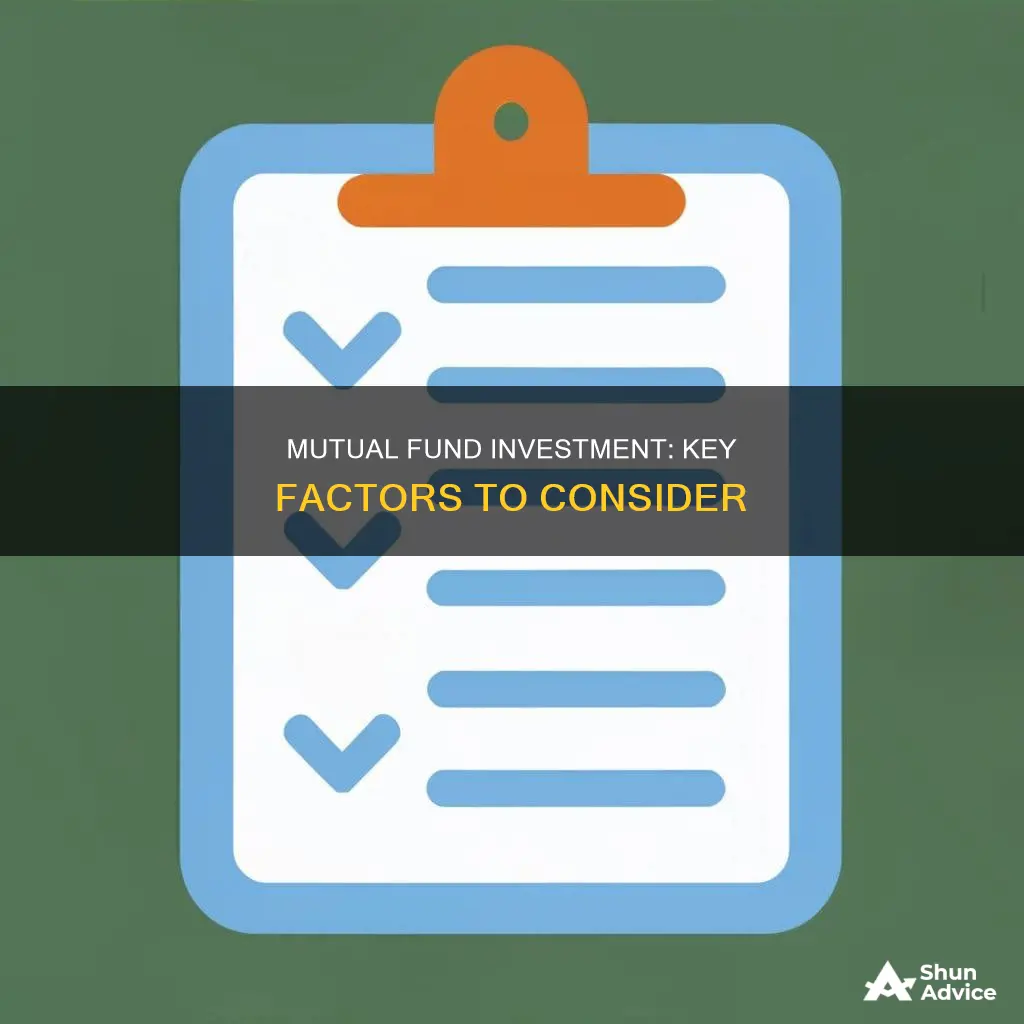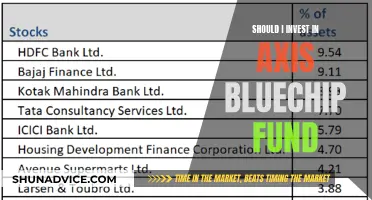
Investing in mutual funds is a popular way to grow your wealth. However, before diving into mutual funds, it's important to conduct thorough due diligence. Here are some key things to consider before investing in mutual funds:
- Investment goals and risk tolerance: Define your financial objectives and risk tolerance. Are you investing for retirement, buying a home, or something else? How much risk can you comfortably take?
- Types and categories of mutual funds: Mutual funds come in various types, such as equity funds, debt funds, hybrid funds, and thematic funds. Each category serves a different purpose and carries a unique level of risk. Choose funds that match your goals and risk tolerance.
- Performance and consistency: Research the historical performance of the mutual fund over different time frames. Look for consistent returns and compare the fund's performance to its benchmark index and peers. Remember that past performance doesn't guarantee future results.
- Tax implications: Understand the tax treatment of different types of mutual funds. For example, long-term capital gains on equity funds may be tax-exempt, while debt funds may incur tax liabilities.
- Expense ratios: Mutual funds charge an expense ratio, which is the annual cost of managing the fund as a percentage of assets. Lower expense ratios are generally more favourable for investors as they result in higher net returns.
- Fund house pedigree and age: Consider the pedigree and age of the fund house. Older funds typically have time-tested processes and internal controls in place.
- Risk factors: Assess the risk factors associated with the fund, including its exposure to different asset classes, sectors, and securities. Consider factors like credit risk, interest rate risk, and market risk.
- Exit load and liquidity: Check if the fund imposes an exit load for redeeming units before a specified duration. Also, evaluate the liquidity of the fund – how quickly can you redeem your units if needed?
- Disclosure documents: Read the scheme document carefully to understand the fund's objectives, strategy, fees, and risks. Ensure it aligns with your investment goals and risk tolerance.
- Diversification: Diversify your mutual fund portfolio based on your investment objectives, age, time horizon, and risk profile. Consider investing across different asset classes and fund managers to minimise risk.
What You'll Learn

Understand the risk levels
Risk levels are a crucial aspect to understand before investing in mutual funds. Each mutual fund category carries a different level of risk, and it's important to assess your own risk tolerance to choose funds that align with your financial goals and comfort level. Here are some key points to consider when understanding the risk levels of mutual funds:
Different Types of Mutual Funds and Their Risks
Firstly, it's important to understand that different types of mutual funds come with varying risk levels. Equity funds, for example, are known for their higher volatility and are suitable for long-term wealth creation. On the other hand, debt funds are considered lower-risk options that focus on income generation and capital preservation. Hybrid funds offer a mix of equity and debt investments, balancing risk and return. It's essential to understand the risk profile of each type of fund before making a decision.
Risk Assessment and Investor Profile
Before investing in mutual funds, it's crucial to assess your own risk tolerance. Consider your financial goals, investment horizon, and comfort with potential losses. Are you a conservative investor seeking regular income and capital safety, or are you an aggressive investor comfortable with higher risk for potential capital appreciation? Your risk tolerance will help guide your investment decisions and determine the types of mutual funds that align with your profile.
Risk Measurement and Ratings
When evaluating specific mutual funds, look for risk measurements or ratings provided by agencies. These ratings assess the fund's risk level based on various factors, giving you an idea of the potential volatility and uncertainty associated with that particular fund. A higher rating typically indicates a lower-risk investment.
Asset Allocation and Diversification
Understanding the fund's asset allocation is essential in assessing its risk level. Diversification across different asset classes, sectors, and securities can help mitigate risk. By spreading your investments across various assets, you reduce the impact of any single investment on your portfolio. Diversification is a risk management strategy used by many investors to balance their portfolios.
Fund Manager and Performance
The fund manager plays a crucial role in the success of a mutual fund. Assess the fund manager's knowledge, experience, and track record. A skilled and experienced fund manager can navigate market conditions and make informed investment decisions to potentially reduce risk and maximise returns. However, it's important to remember that past performance does not guarantee future results.
Lock-in Periods and Liquidity
Some mutual funds have lock-in periods, which restrict your ability to withdraw investments for a specified duration. These lock-in periods can vary, and it's important to understand the liquidity constraints of the fund before investing. Additionally, consider the exit load, which is a fee charged when redeeming units before a certain period. These factors can impact your ability to access your investments and may influence your risk assessment.
In conclusion, understanding the risk levels of mutual funds is essential before investing. By considering the different types of funds, assessing your risk tolerance, evaluating fund ratings, analysing asset allocation, and considering the fund manager's expertise and performance, you can make more informed investment decisions. Remember, investing in mutual funds involves risk, and it's important to carefully consider all factors before committing your capital.
Maximizing Your Roth IRA: Alternative Investment Options
You may want to see also

Compare direct and regular plans
Direct and regular plans are the two variants of any mutual fund scheme. The decision to choose between the two depends on your requirements and investment objectives. Here is a detailed comparison of the two:
Direct Mutual Fund Plans
Direct mutual fund plans allow investors to invest directly with the fund houses, without any intermediary such as a financial advisor or broker. This results in a lower expense ratio as there are no commissions or brokerages involved. Direct plans are suitable for investors who are comfortable with independent decision-making and research, as they are in full control of their investments. These plans offer higher returns in the long term due to the lower expense ratio.
Regular Mutual Fund Plans
Regular plans involve investing through an intermediary such as a financial advisor or a bank relationship manager. As intermediaries sell these plans, they tend to have a higher expense ratio as the fund houses have to pay commissions. Regular plans are suitable for investors who need continuous support and guidance from financial advisors. These advisors assist in the investment process, including deciding where and how much to invest based on the investor's objectives.
Key Differences
Net Asset Value (NAV)
Direct plans generally have a higher NAV compared to regular plans. The higher expense ratio of regular plans due to commissions and brokerages results in a lower NAV.
Returns
Direct plans offer higher returns due to their lower expense ratio. The exclusion of distributor commissions in direct plans leads to higher returns for investors.
Role of Financial Advisor
In direct plans, investors deal directly with the asset management company and make their own investment decisions. In contrast, regular plans involve financial advisors who assist in the investment process and provide advice based on the investor's risk appetite and objectives.
Benefits of Regular Mutual Funds
Despite the higher expense ratio, regular mutual funds offer certain benefits that may appeal to specific investors:
- Financial Advisor Assistance: Financial advisors help identify suitable funds based on risk appetite and objectives, providing a personalized approach to investing.
- Regular Monitoring: Advisors monitor and review the portfolio on the investor's behalf, suggesting changes when needed.
- Goal-Based Planning: Financial advisors help create a customized investment plan aligned with the investor's financial goals, aiding in navigating market fluctuations.
Key Factors for Choosing the Right Mutual Fund Investments
You may want to see also

Be aware of inconsistent returns
When investing in mutual funds, it is important to remember that the returns are not linear. This means that you will not earn the same returns every year. For example, a mutual fund may give you a 10% return in the first year, but only a 2% return in the second year. There might even be periods of no returns. Therefore, it is crucial to be prepared for variability in your annual returns.
To make an informed decision, research the historical performance of the mutual fund over different time frames, such as 1-year, 3-year, and 5-year periods. Look for consistency in returns and compare the fund's performance to its benchmark index and peer group. However, keep in mind that past performance does not guarantee future results. Instead, focus on finding a fund with a consistent track record of steady performance.
Consistency in returns is a hallmark of good funds. A mutual fund scheme that consistently delivers a 10% return is better than one that provides a higher return in the first year but a lower return in the second year. This consistency in performance is important because it helps control losses and gives you a higher chance of earning good returns. For instance, if a fund experiences a 5% fall in a year, it will need to generate an 11% return to cover the loss and provide you with a 5% return. Therefore, a consistent fund will generate better returns on an annualized basis over the long term.
When evaluating the consistency of returns, consider the fund's investment style and the market cycle. Opt for a mutual fund where the fund manager follows a consistent style, regardless of the market cycle. Additionally, check the investment style of the fund manager before investing. Some fund managers may have a bias towards a particular investment style, which can impact the consistency of returns.
Bond Fund Investment: What Percentage is Smart to Invest?
You may want to see also

Assess fund consistency
When investing in mutual funds, it is important to assess fund consistency. This means examining the track record of the fund and looking for consistency in returns. While past performance does not guarantee future results, choosing a fund with a history of steady performance can help control losses and increase the chances of earning good returns.
To assess fund consistency, consider the following:
- Research the historical performance of the mutual fund over different timeframes (1 year, 3 years, 5 years, etc.). Look for consistent returns and compare the fund's performance to its benchmark index and peer group.
- Consider the pedigree and age of the fund house. Older funds typically have more time-tested processes and internal controls in place. Check the history of past performance of the fund house as well as the fund manager.
- Understand the fund's investment strategy and whether it aligns with your financial goals and risk tolerance. Different types of funds, such as equity funds, debt funds, and hybrid funds, have varying levels of risk and returns. Choose funds that match your investment objectives and risk appetite.
- Evaluate the fund's performance in relation to its benchmark index and peer group. This will help you understand how the fund has performed relative to other similar funds.
- Consider the fund's expense ratio, which is the annual cost of managing the fund as a percentage of assets. Lower expense ratios are generally more favourable for investors as they result in higher net returns.
- Assess the tax implications of investing in the fund. Different types of funds are subject to varying tax treatment, so it is important to understand how your investments will be taxed.
By assessing fund consistency and considering the above factors, you can make more informed investment decisions and increase your chances of achieving your financial goals.
Skills for Investment Fund Managers: Expertise for Success
You may want to see also

Diversify your portfolio
Diversifying your portfolio is a crucial aspect of investing in mutual funds. Here are some essential points to consider:
Age and Risk Profile:
Diversification can depend on your age and risk tolerance. Younger investors can opt for greater exposure to equity mutual funds, while those nearing retirement may shift their focus towards debt mutual funds. This strategy ensures that younger investors can take advantage of the potentially higher returns from equity funds, while those closer to retirement age reduce their risk exposure.
Exposure to Different Investment Styles:
Diversification can also mean spreading your investments across different asset management companies (AMCs). This strategy ensures that you are exposed to different investment styles and reduces the risk of having all your eggs in one basket. However, avoid investing in multiple mutual fund schemes from the same AMC, as this may lead to portfolio overlap and reduce the effectiveness of diversification.
Equity Mutual Funds:
When investing in equity mutual funds, it is important to ensure diversification within this category. Invest in equity funds with dissimilar stock holdings to maximise diversification and increase the risk-reward ratio. Avoid identical equity mutual fund schemes to prevent portfolio overlap.
Time Horizon:
Consider your investment horizon when diversifying your portfolio. Equity funds are typically suited for long-term financial goals, such as retirement planning or buying a house, while debt funds are more appropriate for short-term and medium-term goals, such as buying a car.
Other Asset Classes:
While equity and debt funds are the most common, don't forget about other asset classes that can further diversify your portfolio. These include government and corporate bonds, money market instruments, gold, and real estate.
Regular Monitoring:
Diversification is an ongoing process. Regularly monitor your mutual fund investments to ensure they continue to align with your investment goals and risk tolerance. As your circumstances change, you may need to adjust your portfolio accordingly.
By following these strategies, you can effectively diversify your portfolio and reduce risk while maximising returns. Remember, diversification is a key component of successful investing, and it ensures that your portfolio is well-balanced and resilient to market fluctuations.
Vanguard Mutual Funds: Are They Worth the Investment?
You may want to see also
Frequently asked questions
There are several types of mutual funds, including equity funds, debt funds, hybrid funds, and thematic funds. Each type serves a different purpose and carries a different level of risk.
You should choose a mutual fund that aligns with your financial goals and risk tolerance. For example, if you are a conservative investor seeking regular income and capital safety, you may want to invest in debt funds. On the other hand, if you are an aggressive investor seeking capital appreciation, you may opt for equity funds.
Direct plans have a lower expense ratio because they do not charge distributor expenses, trail fees, or transaction charges. This results in higher returns for investors. Regular plans, on the other hand, pay a sales commission to middlemen or brokers, which is added to the expense ratio of the fund.
When comparing mutual funds, consider the fund's rating, net asset value (NAV), expense ratio, entry load, exit load, asset management company (AMC), benchmark, fund manager, holdings, launch date, lock-in period, returns, risk, and minimum investment amount.







